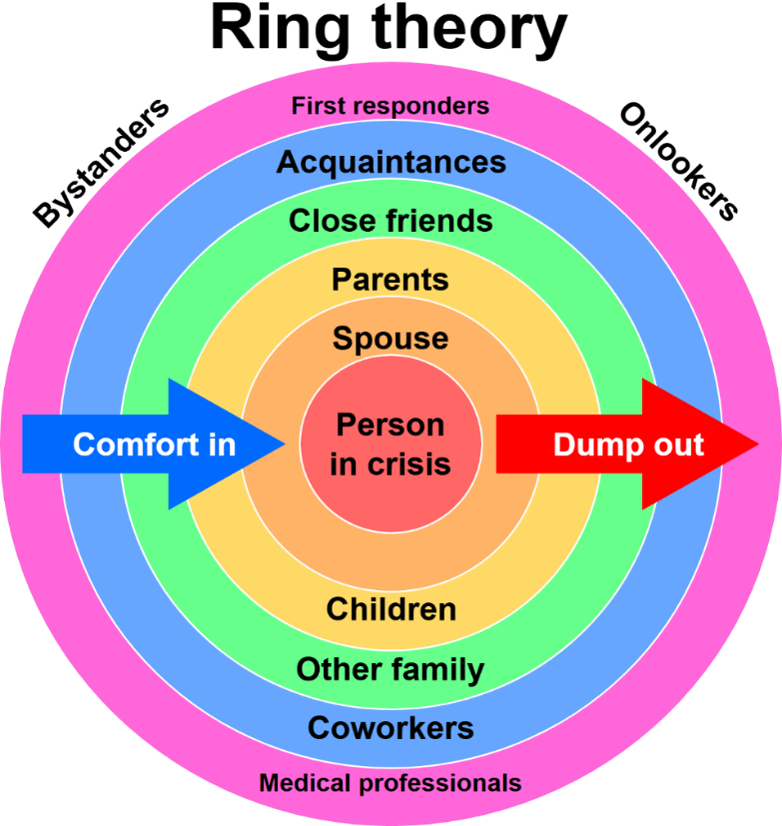 September is National Suicide Prevention Month, a time dedicated to raising awareness about suicide prevention and promoting mental health. Suicide is very personal to me. My wife died from suicide. I wrote what started as a blog but became a longer story about my family’s experience with suicide and offered some lessons we learned by dealing with the disease and the grief that followed her suicide. Since then, my daughters and I have worked, lived, and counseled others about how to deal with those impacted by this awful mental illness. You can read my blog/story here: Mental Health Month 2022 – A Personal Perspective on Suicide. This blog will focus on Ring Theory, an elegant concept to help you and others learn how to deal with people who are suffering not just from suicide but any trauma or crisis.
September is National Suicide Prevention Month, a time dedicated to raising awareness about suicide prevention and promoting mental health. Suicide is very personal to me. My wife died from suicide. I wrote what started as a blog but became a longer story about my family’s experience with suicide and offered some lessons we learned by dealing with the disease and the grief that followed her suicide. Since then, my daughters and I have worked, lived, and counseled others about how to deal with those impacted by this awful mental illness. You can read my blog/story here: Mental Health Month 2022 – A Personal Perspective on Suicide. This blog will focus on Ring Theory, an elegant concept to help you and others learn how to deal with people who are suffering not just from suicide but any trauma or crisis.
Ring Theory is a powerful tool developed by psychologist Susan Silk and her husband Barry Goldman. Precipitated by Susan’s own crisis brought on while dealing with breast cancer, Ring Theory provides a framework for offering support to those who want to help others dealing with trauma or crisis. If you’re experiencing a crisis yourself, and you will at some point in your life, the tool can help you explain to others how they can help you. I feel so strongly about this that I’ve added a diagram that I use to explain and discuss Ring Theory in a leadership course I teach in a graduate level MBA program. The response from students has been positive – “aha” being the most frequent expression in response to the material and classroom dialog. I wish the tool had been developed decades earlier.
Here’s an image available on Wikipedia that visually explains Ring Theory.

The person who has been traumatized or is in a crisis is at the center. As you move toward the outside, familiarity with the person at the center decreases. The rules are simple. The person in the center can express themselves and complain without judgment. Using the arrows as guides, the blue one shows that comfort should be provided from outside-in. The red arrow represents complaining (or Silk’s term “kvetching”) that you can do to someone in a circle further away from the center than you.
Avoid trying to compare a situation you had (or have) with someone in a ring closer to the center. Never offer advice unless specifically asked; then choose your words very carefully. Before speaking, think about what you’re going to say. Are you saying something to make you feel better or make them feel better?
Given my experience I advise people that the sentence, “I’m sorry” is sufficient. There are religious traditions that suggest, “May their memory be a blessing.” I’m not a fan but understand the reason for using it. Though I’ve never done it, if you’re at the center, you might be able help someone else by letting them know what they’ve said is not helpful, “I know you’re sorry but expressing it that way was not as helpful as I’m sorry.” I believe that silence is probably the best response if you’re at the center and someone says something that’s upsetting.
When I was young, there was a squad of well-meaning people, mostly women in our congregation who organized activities to help bridge the gap between devastation and recovery. They took care of the mundane activities that are so difficult to attend to in the midst of great suffering. They brought meals, sometimes for a couple of weeks to ensure the aggrieved didn’t have to cook. And when it made sense to do so, they offered to do grocery shopping, clean the dishes, walk the dogs, feed and take care of other pets, run errands, and attend to the needs of any young ones still at home.
It’s also important if you’re helping someone at the center to think about what you need to maintain the strength to be a helper. Your own physical well-being and mental health is critical. And when someone decides to talk, be a great listener. Familiarize yourself with the stages of grief and its many facets. That will help you validate their feelings. And when you’re listening, don’t interrupt or rush to express yourself. Patience is powerful.
There is little doubt that social support can favorably impact mental health and the healing/recovery processes. Ring Theory offers a compassionate and practical approach to supporting individuals in crisis. During Suicide Prevention Month, let’s commit to understanding and applying this theory to help those in need. Remember, offering comfort and seeking support are both acts of courage and kindness.
If you or someone you know is in crisis, there are options. For immediate support, reach out to the Suicide & Crisis Lifeline by dialing 988. You can also contact the National Alliance on Mental Illness HelpLine at 1-800-950-NAMI (6264) or info@nami.org for guidance and support.
